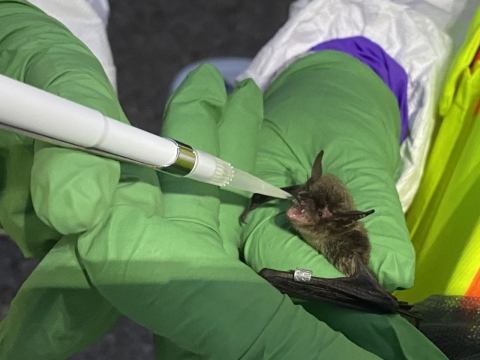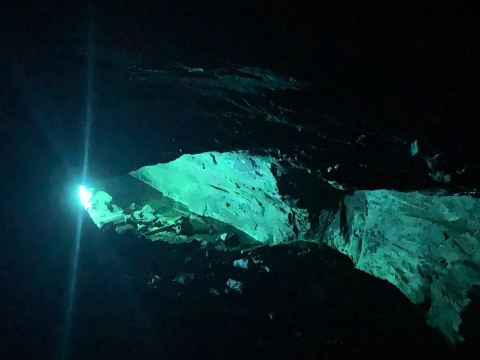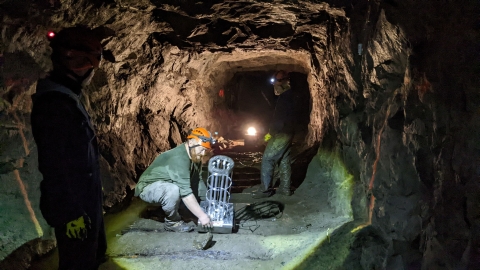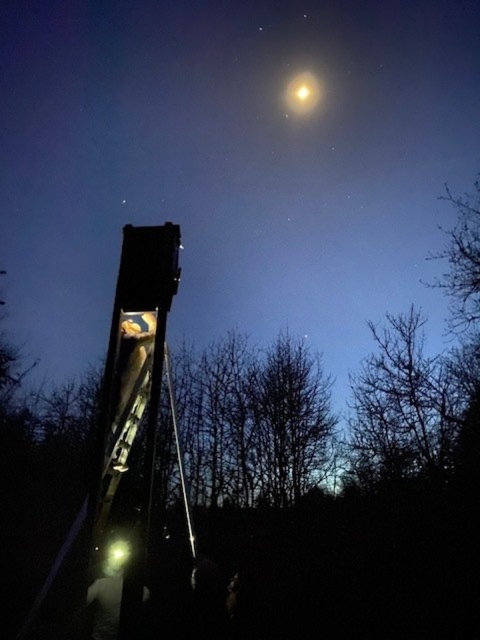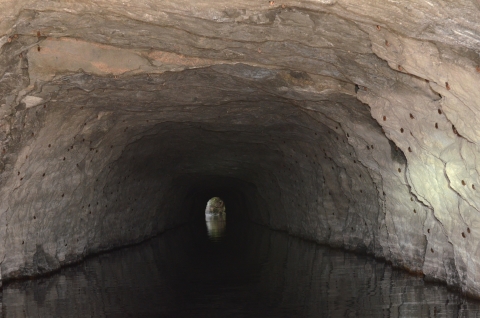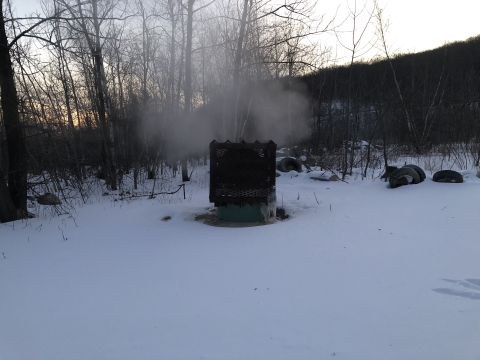In the depths of winter, bats across North America are waking from hibernation dangerously early, plagued with a disease that’s killing millions of their peers. White-nose syndrome, caused by the fungus Pseudogymnoascus destructans, was first documented in 2006 in a cave near Albany, New York. Nearly 20 years later, it’s spread to more than 40 states and eight Canadian provinces. Similar to medical researchers addressing ailments that impact humans, such as autoimmune diseases or cancers, there’s a team of dedicated scientists fighting the disease.
Bats are essential to natural ecosystems and agriculture, working as pest managers, pollinators and seed dispersers. In the United States, bats save the agricultural industry billions of dollars each year by feeding on insects, reducing the need for pesticides.
The U.S. Fish and Wildlife Service is the lead government agency in the United States coordinating the collaborative response to white-nose syndrome. Every year, our White-Nose Syndrome Program awards millions of dollars in grant funding for scientific advancements and management to prevent and treat the disease.
Researchers have been developing and testing a variety of experimental treatment options with our support. Diverse minds working towards solutions — there are about 150 organizations on the white-nose syndrome response team — have generated an abundance of innovative ideas.
“Having a variety of tools gives us opportunities to work on multiple scenarios,” said Dr. Jonathan Reichard, assistant national white-nose syndrome coordinator for the Service. “Different species might require different tools because of how and when we can reach the bats or their habitats.”
Now researchers are testing these treatments on wild bat colonies across the country. Here are a few examples of what’s in the works:
Vaccine
What it is: The leading white-nose syndrome vaccine candidate uses raccoonpox virus modified to express fungal antigens and elicit a protective response in bats. It was developed by Dr. Tonie Rocke, research epidemiologist with the U.S. Geological Survey National Wildlife Health Center, in partnership with Dr. Bruce Klein and Dr. Jorge Osorio at University of Wisconsin, Madison. A leader in the field of wildlife health, Rocke has also worked with vaccines that protect black-footed ferrets from plague and vampire bats from rabies.
How it’s used: Scientists administer the oral vaccine by dropping a liquid dose into each bat’s open mouth. The vaccine is only given once — in the summer or in the fall before the bats begin hibernation.
How it’s working: Vaccinated bats in two large Wisconsin sites, where the disease is established, experienced significantly lower levels of fungal infection compared to those that received a placebo. Now, partners in Washington, Idaho and Texas are testing how well the vaccine works for bats that receive it prior to being exposed to the fungus or immediately after infection. In Idaho, scientists first detected the fungus in Minnetonka Cave in 2021, the same year they began to immunize bats in the area. It typically takes about three years after first detecting the fungus to begin seeing signs and impacts of the disease in a colony.
“[As of March 2024], we haven’t seen any mortality at Minnetonka Cave, and there have been no clinical signs of the disease,” said Dr. Rita Dixon, State Wildlife Action Plan coordinator for Idaho Department of Fish and Game.
What’s next: Scientists are developing additional delivery methods to vaccinate large numbers of bats at once, like an aerosol spray that could be showered onto roosting bats, stick to their fur and be ingested as they groom themselves. Ideally, by producing it in an edible form, biologists will be able to vaccinate bats without capturing or handling them, reducing cost and stress for the animals.
UV-C light
What it is: Adapting methods used by medical facilities — and even locker rooms and grocery stores —to sterilize objects, surfaces and air during the COVID-19 pandemic, researchers from Rutgers University are testing a commercially available UV-C light to kill the fungus in some tunnels, culverts and mines where bats overwinter. The lamp device is about the size of a fire hydrant, portable and can take less than two hours to effectively disinfect a 325-cubic-meter space.
How it’s used: Scientists deploy the UV-C treatment in the hibernation site in late summer — the time of year when no bats are roosting there — to avoid disturbing or harming the bats. The light shines low-dose UV-C radiation on the walls in all directions, disrupting the fungus’s DNA and eradicating as much as possible.
How it’s working: Researchers are testing the UV-C treatment in nine sites across Michigan, New York and New Jersey. Once a year, in late winter, they check a sample of bats in each location to see how much of the fungus that causes white-nose syndrome is on them. It's too soon to jump to conclusions, but early results indicate that after the first year of treatment, fungal loads on the bats had significantly decreased across all sites.
What’s next: Hibernation sites vary in size and complexity — some with vaulted ceilings, some with abundant nooks and crannies — which can impact the effectiveness of the UV-C treatment if the light can’t reach all surfaces. Researchers hope targeting the specific surfaces where bats are known to roost will be enough to keep the fungus under control even if the entire site cannot be treated.
“Another direction would be to work with biotech companies that make these whole-room UV sanitizers to customize machines with hibernation sites in mind,” said Dr. Brooke Maslo, associate professor at Rutgers University. “Creating units that direct light towards the ceiling and are conducive to the wet and uneven surfaces of subterranean habitats would help to increase efficiency of treatments.”
Even without specialized units, one of the benefits of this treatment method — if it proves to be effective — is that it could be relatively easy to implement in hibernation sites on a large scale, because the standard UV-C equipment is already commercially available.
Probiotic
What it is: Many people take a probiotic to improve their gut microbial health. Similarly, scientists are developing a probiotic application to strengthen bats’ natural skin microbiomes to slow fungal growth. In Washington and British Columbia, they’re testing a probiotic cocktail containing four bacterial strains belonging to the Pseudomonas fluorescens complex. This probiotic was developed at McMaster University and Thompson Rivers University and builds on earlier probiotic experiments conducted by researchers from UC Santa Cruz. All four of these probiotic strains were sourced from wings of healthy bats in the Pacific Northwest.
How it’s used: Researchers are testing the probiotic in maternity roosts in British Columbia and Washington during the summer. They combine the freeze-dried beneficial bacteria with clay powder and use compressed air to blow it into a bat box at night while the bats are away. Upon the bats’ return, the probiotic-laden dust covers their bodies and wings.
How it’s working: The earlier UC Santa Cruz study tested a probiotic on hibernating bats in Wisconsin and found that their survival rate increased from 8.4% to 46.2%. Because bats in western regions don’t hibernate in large, easily accessible roosts, researchers are administering the new probiotic to colonies in the summer to test whether it will protect the bats through the following winter.
“In Washington, we are starting the second year of the probiotic treatment this summer (2024) so it’s still early to say how it is working. We will analyze year-to-year survival of marked bats in hopes of providing clarity on the efficacy of this treatment,” said Abby Tobin, bat biologist with the Washington Department of Fish and Wildlife.
What’s next: Biologists in Washington and British Columbia currently administer the probiotic twice each summer but still need to determine the ideal frequency. Factors such as temperature and relative humidity might impact the probiotic bacteria’s survival and could determine how often it needs to be readministered. Fortunately, in southwest British Columbia, scientists are noticing that the probiotic bacteria can persist through the winter.
“Persistence of the bacteria has improved over the years, suggesting that perhaps the layer of clay that has built up in the boxes allows the bacteria to survive hot and cold,” said Dr. Cori Lausen, director of bat conservation for the Wildlife Conservation Society Canada.
This could mean that after biologists apply the clay and probiotic to one location for a few summers — building up the layer of clay — they might be able to be hands off, letting the good bacteria persist and propagate on their own.
Once there are proven results, other elements of this treatment option will need to be solidified before it can be used widely, including upscaling to produce the probiotic in larger quantities and by other labs.
Volatile organic compounds: B-23 and decanal
What it is: This treatment, developed by research teams at Kennesaw State University and Georgia State University, is similar to humans using essential oils on a ringworm infection — but imagine applying your tea tree oil with a fog machine. B-23 is a synthetic version of a compound produced by a fungus found in Bolivian wild pineapple, and decanal comes from orange peels. Both have antimicrobial properties and, in a gaseous form as volatile organic compounds, are effective against the fungus that causes white-nose syndrome.
How it’s used: At one test site in Georgia, scientists float a boat affixed with a remotely operated mosquito fogger through a tunnel. The machine shoots the formula in aerosol form, fogging up the hibernation site while tricolored bats hibernate undisturbed on the walls. The antifungal properties of the compounds slow or stop the growth of the fungus on bats. The treatment is implemented multiple times a winter.
How it’s working: Since beginning this treatment in 2017, the tunnel’s bat population has been slowly recovering. Originally, the researchers were only using B-23, but after adding decanal to the formula, the bat population began to rebound, and visible signs of white-nose syndrome decreased. Notably, in 2024, they discontinued the treatment in the tunnel, and visible signs of white-nose syndrome are once again noticeable on a large proportion of the bats.
What’s next: Kennesaw State University is testing the impact of the volatile organic compounds on the fungus in climate-controlled shipping containers made to mimic a cave environment, but without any bats. They want to learn more about the dosing amounts to stop the fungus and to understand how B-23 and decanal might affect the healthy microorganisms that live on bats — a natural line of resistance against the fungus — as well as other creatures living in the hibernation sites. They’re also investigating alternative volatile organic compounds that may be more effective or easier to produce and deliver.
“There are natural microbes that occur in cave systems that are important to many other organisms, so testing the impacts of the chemicals on the fungus and other microbes in this controlled shipping container environment is an important step to understand the potential effects,” said Pete Pattavina, the Service's Southeast regional white-nose syndrome coordinator.
Temperature regulation
What it is: The fungus that causes white-nose syndrome grows best in a temperature range of 12°C to 15.8°C — if it’s colder, it will grow more slowly. Researchers from the Pennsylvania Game Commission, Ohio University, Temple University, University of Cincinnati, Lock Haven University and CNX Resources tested the effectiveness of lowering mine temperatures to reduce the fungus’s impact on bats.
How it’s used: Scientists cooled six bat sites in Pennsylvania using various passive techniques, such as blocking an abandoned mine’s lower entrance to keep cold air from leaking out, adding more entrances to pull cold air in and drilling a hole through the top of a mine to vent warm air — all without air conditioners or fans. Each site’s temperature was manipulated to be at least 2°C lower than the optimal temperature for the fungus.
How it’s working: For multiple species, scientists saw the number of bats increase in the cooled sites by more than what they would expect with normal reproduction. Locations that were cooled the most — where midwinter temperatures were within 3°C to 6°C — had the best results. When temperature manipulation began at one hibernaculum, it had just one tricolored bat and two little brown bats. In eight years, those numbers increased to 83 and 753 bats, respectively. The increase at the cooled sites suggests that bats are able to find and select the colder locations — places where they are less likely to develop white-nose syndrome.
Scientists implementing this method aim to create a range of stable temperatures throughout the site — rather than cooling an entire site to a single, specific temperature — so bats can find hibernation spots that meet their needs.
What’s next: The implication isn’t to start cooling all caves; we need to be careful — too cool, the bats might leave or deplete their fat reserves during hibernation. However, the results do highlight the importance of conserving caves and mines that include cooler locations — whether naturally occurring or manipulated — as they could provide refuge into the future.
“This approach may provide a way to help hedge any future climate change climate change
Climate change includes both global warming driven by human-induced emissions of greenhouse gases and the resulting large-scale shifts in weather patterns. Though there have been previous periods of climatic change, since the mid-20th century humans have had an unprecedented impact on Earth's climate system and caused change on a global scale.
Learn more about climate change impacts,” said Greg Turner, wildlife biologist with the Pennsylvania Game Commission. “If our winters are shorter and warmer, only sites that have the ability to maximize the influx of cold air and stave off the impacts of warmer summer air may be suitable for bats in future years. Many preferable sites used today may become too warm.”
The perfect solution
This is just a snapshot of the long list of projects in progress and ideas in development across the continent. With multiple treatments being field-tested at a relatively small number of sites, the White-Nose Syndrome Program is looking to expand experimental application of treatments with adaptive approaches that will improve understanding of the efficacy of these potential solutions.
"We're also still looking for innovative new tools,” Reichard said. “The dream treatment would be something that can be used in almost any situation and benefits bats for years after a single application.”
With so many dedicated experts exploring a variety of prevention and treatment methods, the likelihood of generating world-changing options is high — solutions that could even mitigate other wildlife diseases in the future.
As with most medical advancements, a solution takes years to develop and test, but Reichard is optimistic.
"It's really the community of people working on and doing good things for bats that gives me hope,” he said.


